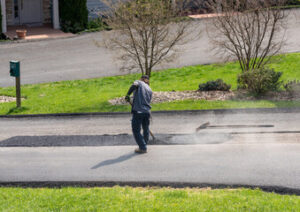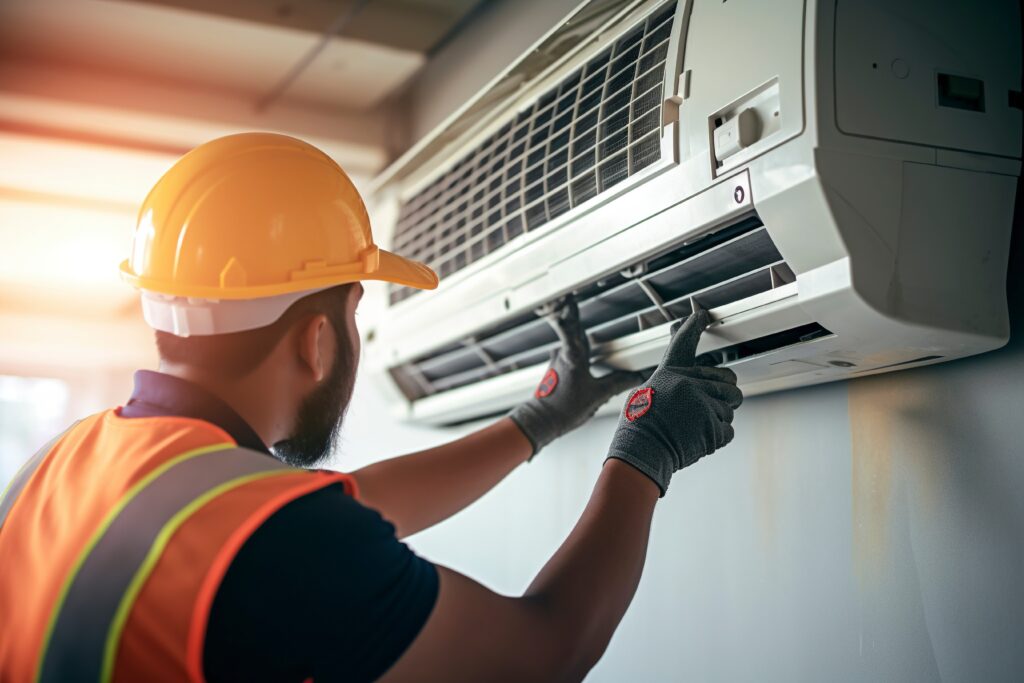Sealcoating is a protective layer that’s applied to asphalt pavement. It helps preserve the surface of a parking lot or driveway, saving you money on costly repairs in the future.
For sealcoating to work, the asphalt must be clean and dry. Workers will blow or sweep the area before beginning the process. Visit https://www.rochesternysealcoating.com/ to learn more.

Asphalt is a rock and aggregate material held together with something called binder. The sun’s UV rays break down asphalt over time by degrading the binder, which in turn, causes the surface to deteriorate and become brittle. Sealcoating helps to prevent this and prolongs the life of your asphalt pavement.
In fact, a proper asphalt maintenance program including regular sealcoating can double the life of your asphalt pavement and significantly reduce long-term repair costs. Sealcoat is a mixture of liquids and small particles like sand that acts as a protective layer over your asphalt, filling in surface damage and keeping out water, oil and other chemicals, as well as UV rays.
While you can’t completely prevent oxidation – the deterioration of your asphalt’s binder caused by the air and the sun’s UV rays – sealcoating helps to slow it down. Without the protection of a good seal coat, your pavement will lose its oil and begin to dry out, which in turns makes it more susceptible to cracking.
With a regularly scheduled and applied seal coat, your asphalt pavement can easily withstand the pressure of cars driving on it without any cracking or damage to the surface. In addition, the seal coat is resistant to gasoline spills and antifreeze, which can stain and corrode your asphalt if allowed to sit for extended periods of time.
Aside from the structural benefits, seal coating also helps your asphalt look better. The dark, black appearance of your newly sealed pavement gives it a fresh, clean look that improves the curb appeal of your property and makes it look well-maintained. Additionally, smooth, uncracked asphalt is much easier to keep clean than cracked and damaged asphalt.
Aside from the cosmetic advantages, a properly done sealcoat will help to protect the workers who will be working on your asphalt when it’s being sprayed and broomed. The fumes and toxins from these chemicals can be dangerous if they are inhaled or contacted through skin and lung contact, but the seal coat creates a barrier between them and your workers. This ensures that the work can be done safely and efficiently, protecting the health of everyone involved.
Increases the Life of Your Pavement
Asphalt pavement can last up to 15 years or more with regular maintenance including sealcoating. The protective coating halts weather damage, liquid penetration, and other common pitfalls that cause deterioration. This dramatically reduces the risk of extensive cracking and potholes, which can double the lifespan of your asphalt surface.
A sealed pavement surface resists oil and chemical spills, minimizing staining and making cleaning much easier. The coating also optimizes drainage, reducing pooling and preventing hydroplaning during rain or snow. This can significantly enhance safety for pedestrians and motorists, ensuring the smooth and safe movement of traffic.
Sealcoating strengthens the asphalt surface by filling microscopic cracks, preventing water infiltration and re-bonding the broken pieces of aggregate. This prevents the formation of major issues like potholes and rutting, minimizing the need for costly repairs or replacement.
Asphalt is made up of a mix of sand and gravel aggregate and a petroleum binder. Over time, oxidation and the elements wear down the sand and gravel while the petroleum binder becomes dry and crumbly. The seal coat blocks the oxidizing substances and protects the binder, keeping the pavement pliable and flexible for longer.
As an added benefit, sealcoating reduces the amount of dirt and debris that collects on your driveway or parking lot. This makes upkeep much simpler and faster, saving you time and money. In addition, the sealcoat helps to block harmful UV rays that can discolor and bleach the concrete.
The process of applying a seal coat is relatively simple and quick, though there are some important steps that must be taken to ensure success. First, workers must choose a day with low humidity and temperatures above 50 degrees Fahrenheit. High levels of moisture and excessive heat can harm the curing process, which is essential for a long-lasting and effective coat.
It’s also important to note that sealcoating cannot repair existing cracks, potholes or other damaged areas of your pavement. It’s recommended that you hire a professional contractor to assess your pavement and recommend any necessary repairs before starting the application process. Also, avoid putting heavy machinery or equipment on the newly-sealed surface, as this can cause permanent indentation and damage to the sealcoat.
Adds Value to Your Property
A fresh sealcoating will transform your driveway or parking lot into a sleek, jet-black canvas that exudes elegance and sophistication. This visual impression encourages prospective buyers or tenants to take a closer look and ultimately boosts the value of your property.
Cracked and weathered asphalt leaves a negative initial impression that conveys a lack of care and upkeep. Conversely, a vibrant and well-maintained sealcoated surface is a significant selling point and suggests that your property has been lovingly maintained over the years.
Water has a tendency to soak into untreated asphalt and seep down to the bottom, which can spread and even damage the foundation. Sealcoating stops this from occurring by creating a barrier between the pavement and the surrounding environment. In turn, this reduces the likelihood of costly repairs in the future.
In addition to preventing cracking and erosion, asphalt sealcoating also prevents oil and gas from absorbing into the surface. When auto fluids such as oil and gasoline are allowed to soak into the surface, it weakens it and causes premature wear. When the asphalt is protected by a sealcoat, it stays strong and flexible for a longer lifespan.
Maintaining Safety
The smooth surface of a sealcoated parking lot or driveway makes it easy to wipe away spills and stains. In contrast, unsealed surfaces can harbor algae and mold, making them perilous to walk on. Sealcoating ensures that your property is safe for pedestrian traffic and is aesthetically pleasing.
Aside from improving curb appeal, the smooth surface of a sealcoated parkinglot or driveway is a breeze to clean. Spills and stains can be wiped off with ease without the need for abrasive chemicals. This simple maintenance step can drastically reduce the time and money spent on cleaning your property.
Ultimately, the benefits of sealcoating far outweigh the initial investment. Forestalling expensive future repairs, preserving and elevating property value, sustaining cleanliness, and enhancing longevity all add up to substantial fiscal savings in the long run. These are just a few of the reasons why many asphalt contractors include sealcoating as a standard part of their services.
Reduces Maintenance
Many property owners are amazed at how low-cost and easy it is to get their asphalt surfaces resealed. When compared to the cost of repairing asphalt damage or even the full resurfacing of a lot, it is a very small price to pay for such a long-term investment.
One of the main reasons a parking lot needs to be resealed is because of the wear and tear from automobile traffic. Keeping your parking lot well-maintained by applying seal coats will help prevent this damage, and the resulting cracks and holes, from becoming bigger and more costly in the future.
Another reason to reseal your parking lot is to protect it from oil and gas spills. This is important because when oil or gasoline seeps into the pavement, it breaks down the structure of the asphalt. This damage can cause the asphalt to become brittle and less flexible, which makes it more likely to crack under the pressure of vehicle tires. By protecting the asphalt from these chemicals and stains, you can extend the life of your parking lot and reduce the need for repairs and resurfacing.
In addition, when a parking lot is sealed, the surface will be protected from the weather. Depending on the temperature, moisture and sun exposure, the asphalt can become soft or cracked. This can lead to potholes and other damage to the surface. Sealcoating the asphalt will keep the surface dry, and will also make it more resistant to UV rays, which will prolong its life.
A final reason to have your parking lot resealed is to improve its curb appeal. If your parking lot has visible damage, it can deter potential customers or tenants from visiting your business. A well-maintained parking lot looks great, and will attract and retain clients and tenants for years to come.
Before resealing your parking lot, it is important to prepare the area. This includes cleaning the surface and making sure there are no pests that can be attracted to the chemicals used in the sealant. You will also need to shut down any sprinkler systems and turn off any fertilizers, as these chemicals may react with the sealant. Once the surface is ready, you will need to block off the area that will be resealed. If possible, it is best to completely close your parking lot for a day or two during the process. However, if you need to keep the lot open, it is possible to have the workers partition the area and work on one section at a time. This will allow you to use the other areas while the new surface is being resealed.





